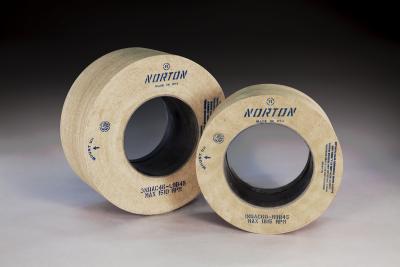
Saint-Gobain Abrasives offers a new line of centerless grinding wheels to its bonded abrasives portfolio. The Norton Century45 centerless bond platform features an exclusive chemistry that greatly improves grain retention in the wheel. Better grain retention means wheels are constructed with more porosity for a given hardness. This translates into wheels having a hard grade with the performance of a softer grade, providing a range of benefits.
Norton Century45 wheels are available with ceramic, aluminum oxide, silicon carbide grain and abrasive blends to maximize user grinding safety and efficiency. These wheels reduce cycle times by up to 50 percent, improve stock removal by more than 30 percent and increase wheel life from 30 to 100 percent versus standard products on the market, according to the company.
Norton Century45 provides a continually sharp wheel face that achieves over 30 percent more stock removal, reducing grinding times through fewer passes to achieve optimal results. Operators will generate more parts through reduced production cycle times when using Norton Century45 wheels.
Norton Century45 centerless grinding wheels also can decrease grinding noise levels by as much as 23.2 dB, even when grinding hard-to-grind alloys such as Inconel 718, thus increasing operator safety.
To put this reduction in context, many commercially available foam ear plugs offer noise reduction ratings in the range of 25 to 28 dB.
Norton Century45 is ideal for bar grinding, fastener and tool grinding, automotive or aerospace components, as well as bearing applications. Whether in a high production grinding facility or job shop, Norton Century45 can significantly reduce grinding costs while increasing safety and production throughput.
Contact Details
Related Glossary Terms
- abrasive
abrasive
Substance used for grinding, honing, lapping, superfinishing and polishing. Examples include garnet, emery, corundum, silicon carbide, cubic boron nitride and diamond in various grit sizes.
- alloys
alloys
Substances having metallic properties and being composed of two or more chemical elements of which at least one is a metal.
- aluminum oxide
aluminum oxide
Aluminum oxide, also known as corundum, is used in grinding wheels. The chemical formula is Al2O3. Aluminum oxide is the base for ceramics, which are used in cutting tools for high-speed machining with light chip removal. Aluminum oxide is widely used as coating material applied to carbide substrates by chemical vapor deposition. Coated carbide inserts with Al2O3 layers withstand high cutting speeds, as well as abrasive and crater wear.
- centerless grinding
centerless grinding
Grinding operation in which the workpiece rests on a knife-edge support, rotates through contact with a regulating or feed wheel and is ground by a grinding wheel. This method allows grinding long, thin parts without steady rests; also lessens taper problems. Opposite of cylindrical grinding. See cylindrical grinding; grinding.
- grinding
grinding
Machining operation in which material is removed from the workpiece by a powered abrasive wheel, stone, belt, paste, sheet, compound, slurry, etc. Takes various forms: surface grinding (creates flat and/or squared surfaces); cylindrical grinding (for external cylindrical and tapered shapes, fillets, undercuts, etc.); centerless grinding; chamfering; thread and form grinding; tool and cutter grinding; offhand grinding; lapping and polishing (grinding with extremely fine grits to create ultrasmooth surfaces); honing; and disc grinding.
- hardness
hardness
Hardness is a measure of the resistance of a material to surface indentation or abrasion. There is no absolute scale for hardness. In order to express hardness quantitatively, each type of test has its own scale, which defines hardness. Indentation hardness obtained through static methods is measured by Brinell, Rockwell, Vickers and Knoop tests. Hardness without indentation is measured by a dynamic method, known as the Scleroscope test.
